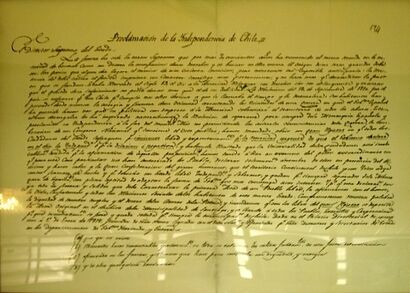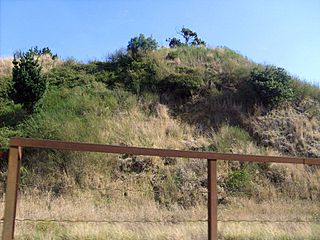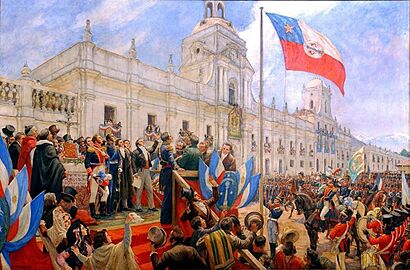Chilean Declaration of Independence facts for kids

The Chilean Declaration of Independence was a very important paper. It said that Chile was now a free country. It would no longer be ruled by the Spanish Empire. Bernardo O'Higgins, a key leader, approved it on February 12, 1818. This happened in Talca. The date on the paper was January 1, 1818. The official ceremony took place on February 12, 1818. This was exactly one year after the Battle of Chacabuco.
The first copy of this document was damaged. It had notes written by O'Higgins. In 1832, a new copy was made. It was sent to Peru for O'Higgins to sign. Then, other important people in Chile signed it too. This copy was kept in the Palacio de La Moneda. Sadly, it was destroyed during fighting in 1973.
Contents
Why Chile Declared Independence
By 1817, the Chilean War of Independence was almost over. Everyone knew that Chile would soon be independent. Even though Chile had been acting like a free country for years, it had not officially declared independence.
One of the first steps towards independence was in 1812. José Miguel Carrera created a set of rules. These rules said that no orders from outside Chile would count. Anyone trying to enforce them would be punished. However, these rules still recognized the King of Spain.
After the Battle of Chacabuco, Chile had its own government. It controlled much of the land. Chile also had its own flag, coat-of-arms, and money. These things showed that Chile was already acting like an independent country. So, there was no rush to make a formal declaration. Other countries like the United States of America and Argentina had already done this.
Bernardo O'Higgins, the leader of Chile, knew there could be problems. He thought declaring independence too soon might be difficult. Chile was still fighting against the Spanish. Also, the country needed to be stable inside first. So, they decided to let the people vote on it. This vote was called a plebiscite.
How People Voted for Independence
On November 13, 1817, the government made an important decision. They announced that people would vote on independence. This vote would last for fifteen days. People in Santiago and other towns could sign if they wanted independence. They could also sign if they were against it.
The government sent out the voting forms. Important leaders like Luis de la Cruz signed the decree. They told everyone to share the forms quickly.
The vote showed that most people wanted independence. Many who disagreed did not vote. They were afraid of being punished. In some areas, like Concepción, the vote was not fully completed. This was because of ongoing fighting.
After checking the votes, the government started planning. They wanted to make a grand declaration of independence. This was also when they heard bad news. A new Spanish army was coming to try and take Chile back. This army was led by Mariano Osorio.
Since the people had voted for independence, a formal document was needed. This document would clearly state the will of the Chilean people. It would be like declarations from other countries. They also planned to publish a paper explaining why Chile was declaring independence. Miguel de Zañartu and Bernardo Vera y Pintado were in charge of writing these.

In late 1817, O'Higgins was fighting the Spanish near Talcahuano. His forces had to retreat. They went to a place called Morrillos de Perales. On January 1, 1818, a message was written there. It said Chile was a "free and sovereign country." It was written on a drum, according to stories. This message was sent to the Spanish commander. Many people see this as Chile's first declaration of independence.
The Official Independence Ceremony
The official ceremony for declaring independence was set. It would happen on February 12, 1818. This was the first anniversary of the Battle of Chacabuco.
On February 9, the plans for the celebrations were announced. The events in Santiago began on February 11. Cannons were fired from Cerro Santa Lucía. On February 12, all the leaders gathered. They stood on a stage in front of the Plaza de Armas in Santiago.
The ceremony began with a speech. Then, Minister Miguel de Zañartu read the Act of Independence. After that, important people took an oath. They swore to support Chile's independence. José de San Martín, the army general, also took the oath. Finally, the Mayor of Santiago swore the oath to all the people.
On February 13, a special church service was held. The next day, a thanksgiving Mass took place. A speaker from Buenos Aires congratulated Chile. The public celebrations in Santiago lasted until February 16. The declaration itself was given to many people. Another document, explaining the reasons for independence, was also shared.
In Talca, O'Higgins led a similar ceremony on February 12. The army swore their oath. There were gun salutes, a Mass, and public parties. Over the next few days, many other cities and towns in Chile declared independence. They held their own celebrations. For example, La Serena declared independence on February 27. Copiapó had its ceremony on March 27 and 28.
Later, on June 15, 1820, Valdivia joined the new nation. This happened after Thomas Cochrane captured the city from the Spanish. Finally, on January 22, 1826, Chiloé also became part of Chile. This was after the Spanish signed a peace treaty.
See also


